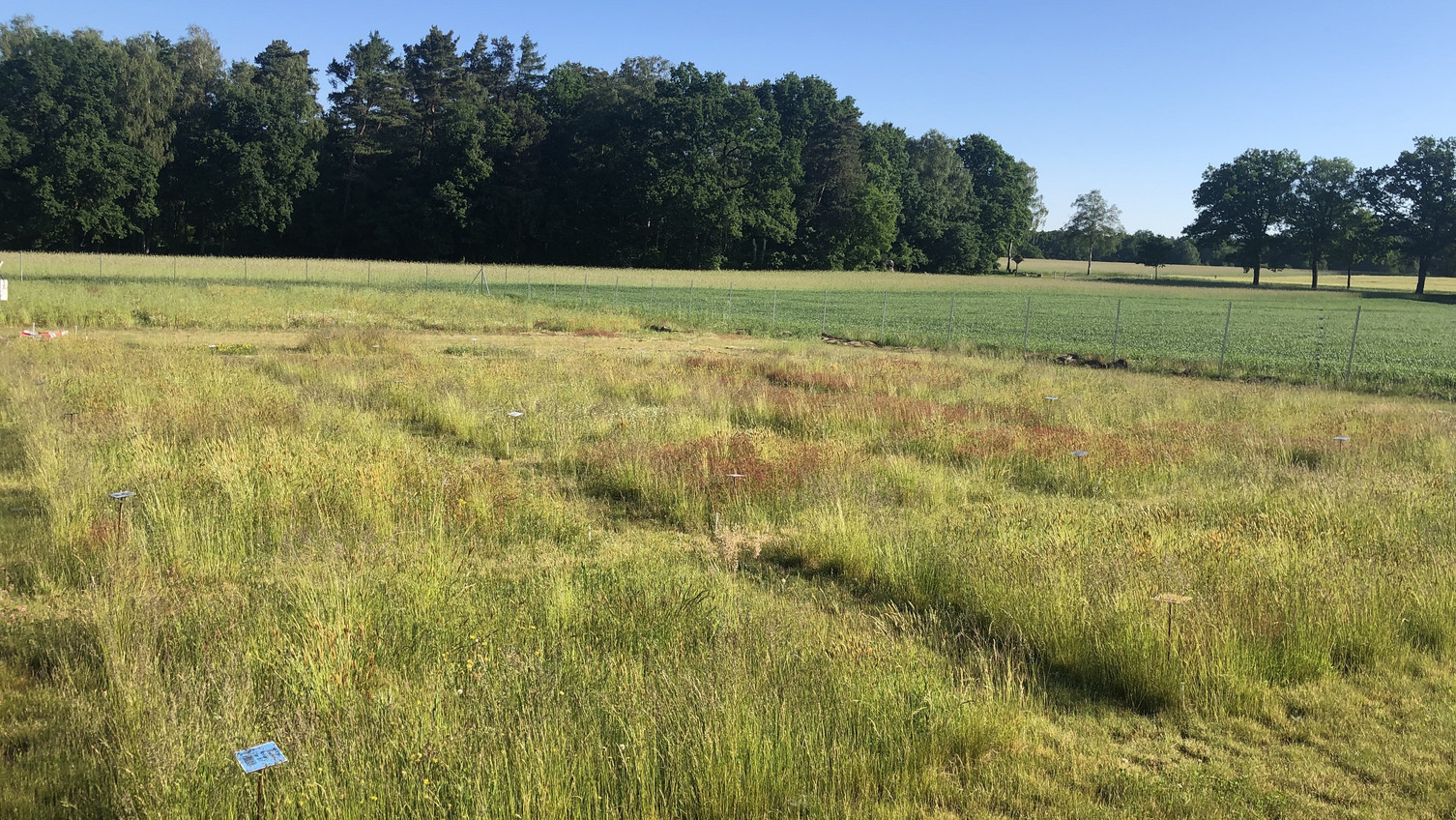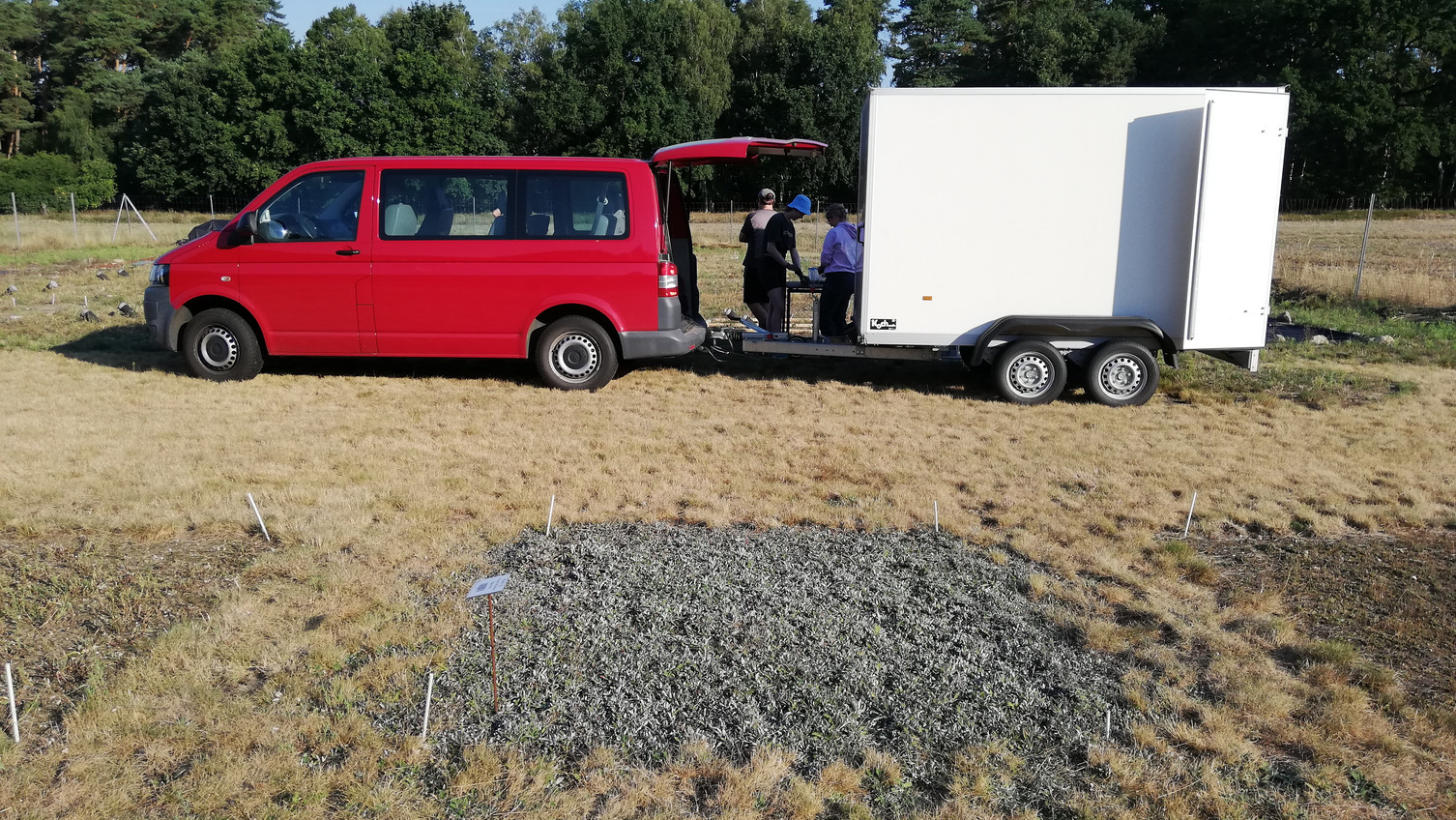Bachelor & Master Projekte
We are looking for dedicated bachelor's and master's students who are interested in experimental studies and want to write their thesis as part of one of our research projects.
Come study how history matters in ecology, in our long-term POEM grassland experiment that studies the role of plant order of arrival in a series of field experiments in the beautiful Lüneburger Heathland!
MSc/BSc thesis project offers
We are looking for two or three motivated students who wish to carry out their MSc or BSc thesis at the Institute of Ecology in the group of Prof. Vicky Temperton working with Dr. María Trinidad Torres García and team. We offer the possibility to be part of the POEM (PriOrity Effects Mechanisms) project, a long-term grassland experiment located in Niederhaverbeck that contributes to understand and better predict grassland restoration outcomes via studying the role pf priority effects.
For more information on POEM including a small introductory film, see https://www.benjamindelory.com/poem.html
Priority effects refer to the impact that species that arrive and establish before others can have on the establishment and success of species that arrive later (e.g. history of the assembly of species in the community). Such priority effects can influence ecosystem functions such as productivity (both in shoots and roots) as well as plant diversity outcomes. With this experiment, we investigate how the order of arrival of plant species from different functional groups (i.e., legumes, grasses and forbs) affects aboveground and belowground dynamics. We already have long-term data on the story so far, both for the aboveground and the belowground. In particular belowground we found that when we sow legumes or forbs six weeks earlier than the other two groups, a concentration of deeper roots at around 40cm depth appeared. We have set up two experiments so far (POEM 1 and POEM 2) and are setting up a third one in 2025 (POEM 3), which will have a much longer sowing interval between the first and the second sowing (one year instead of six weeks): here we hope to find priority effects aboveground.
Here, we offer two possibilities, to work with (1) aboveground or (2) belowground productivity and answer one of the following questions:
- How order of arrival affects aboveground productivity (aboveground biomass production of different plant species in the communities)
- How order of arrival affects belowground productivity (root depth and density, using Minirhitrons, including taking photos of the roots in tubes, to assess root density over time)
Thesis 1. Aboveground productivity
Aboveground biomass is commonly used to assess priority effects since it is directly related to productivity and yield. The student will combine fieldwork (between June/July) to collect and classify plant material and lab work to assess aboveground biomass. The student will take advantage of POEM experimental site where fieldwork will be developed and the lab facilities at the Institute of Ecology.
The student will improve their skillset by:
- Conducting fieldwork activities such as collection and identification of grassland species.
- Performing lab work including sample preparation and analysis.
- Understand and applying statistical analysis of the data.
- Collaborating with an international and diverse team
- Contributing to long-term dataset in a long-term field experiment, which can tell us much more than short term experiments about natural dynamics in nature.
Thesis 2. Belowground productivity
We are also interested in monitoring root growth since deeper roots would potentially allow plant communities to overcome extreme weather events. The student will have opportunity to take advantage of the lab facilities at the Institute of Ecology and the minirhizotrons installed in the field at the POEM experimental site in Sub-Experiment POEM 2 and newly installed Minirhizotrons in POEM 3. The minirhizotrons are acrylic tubes installed in the ground to monitor root development over time. This is a state-of-the-art method for non-destructively measuring roots. The student will combine fieldwork to monitor the root system at community level (monthly sampling of root growth through image acquisition from April to August approx.) and computer work to analyse the images obtained.
Opportunities to improve your skillset and experience by:
- Conducting fieldwork activities such as collection of root samples and root images or learning to identify dry acidic grassland species during harvesting of the aboveground plant community.
- Performing lab work including sample preparation and analysis.
- Understanding image and data analysis using AI and convolutional networks to train the computer to know what is and what is not a root in images.
- Collaborating with an international and diverse team.
Timeframe? Fieldwork would start already in April (helping set up the third experiment POEM 3) and the main work would be late June/July for the harvest (for the aboveground) and throughout the summer season for the belowground measurements (measuring root dynamics around once per month).
Interested? Please contact Dr. María Trinidad Torres García at the Institute of Ecology, maria.torres_garcia@leuphana.de
 ©Temperton/Leuphana
©Temperton/Leuphana
Come study A Real-World Lab (Sowing Lab) in a biodiversity project that spans both agriculture and ecological restoration:
MSc/BSc thesis project offer this summer!
We are looking for one or two students to come work in the exciting GrünlandVielfalt project run by Lunja Ernst, Ute Petersen - Schlapkohl and Nadine Köller at the Aktion Fischotterschutz in Hankensbüttel in Lower Saxony (1 h south of Lüneburg) in collaboration with Prof. Vicky Temperton at the Institute of Ecology at Leuphana. This is a project is testing knowledge from academic biodiversity and priority experiments in the real world, with the Aktion Fischerotterschutz and local farmers, all with the aim of increasing the biodiversity and multifunctionality of the grasslands of the area. Outcomes from this work will very likely have a real impact in the real world around Gifhorn and further afield. See Webpage: https://aktion-fischotterschutz.de/projekte/laufende-projekte/gruenlandvielfalt/das-gruenlandvielfalt-projekt.
When? This May and June 2025 to take part in assessing the plant biodiversity outcomes of the living lab sowing treatments.
What? In this project the aim is to restore grasslands near Hankesbüttel by a) sowing different biodiversity and priority treatments b) rewetting drained moorland and grassland and c) reconnecting more biodiverse patches across the river catchment of the Ise river. Within the Sowing Lab (Ansaat-Labor) Lunja and co have set up large experimental plots across around fourteen different grassland sites along the Ise river south of Wahrenholz.
- Biodiversity and Fertilizer plots with either medium or high diversity seed mixtures sown in autumn 2024, and plots that will either receive no fertilizer, 25kg N per hectare per year or 50 kg N per ha /yr. Fourteen different grasslands have been sown.
- A priority experiment on 9 grasslands sites – where either grasses, legumes or forbs are sown 6 weeks before the remaining seed mixtures to test whether order of arrival can affect ecosystem functioning (including hay productivity). Five of the 16 sites could not be sown in autumn 2024 due to extremely wet conditions – these will be sown in October 2025. Each treatment (see Figure 1)
Who are you? We are looking for someone who preferably knows some plant species and is open for taking a fun learning dive into getting to know how to assess vegetation (which species are found and in what abundance?) with the help of Lunja Ernst and Ute and their team. You will be doing vegetation assessments either in the Biodiversity or the Priority Plots within the Sowing Living Lab.
You have a driver’s license and are willing to work in the field (in the grasslands) near Hankensbüttel for a number of days in a row in May /and or June 2025. There is the option to stay at the Youth Hostel (payment will be covered by the Temperton Professorship at Leuphana). During these phases, it will be necessary to work full days and stay overnight near the field sites. Lunja and co are a fun group, and this is a rewarding experience that will also equip you with important plant species identification skills.
If you are interested, please contact Professor Vicky Temperton (Vicky.temperton@leuphana.de) soon!
Many thanks!
Look forward to meeting you.


